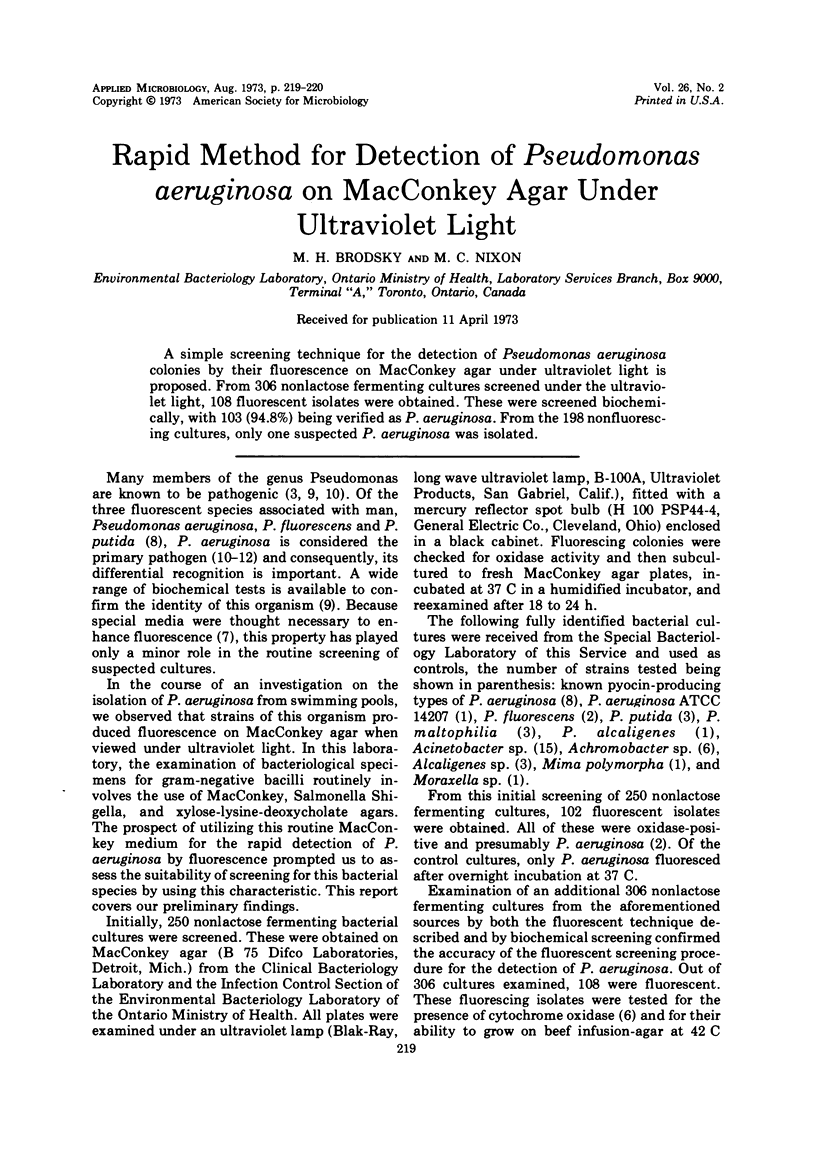Abstract
A simple screening technique for the detection of Pseudomonas aeruginosa colonies by their fluorescence on MacConkey agar under ultraviolet light is proposed. From 306 nonlactose fermenting cultures screened under the ultraviolet light, 108 fluorescent isolates were obtained. These were screened biochemically, with 103 (94.8%) being verified as P. aeruginosa. From the 198 nonfluorescing cultures, only one suspected P. aeruginosa was isolated.
Full text
PDF

Selected References
These references are in PubMed. This may not be the complete list of references from this article.
- Brown M. R., Foster J. H. A simple diagnostic milk medium for Pseudomonas aeruginosa. J Clin Pathol. 1970 Mar;23(2):172–177. doi: 10.1136/jcp.23.2.172. [DOI] [PMC free article] [PubMed] [Google Scholar]
- GABY W. L., HADLEY C. Practical laboratory test for the identification of Pseudomonas aeruginosa. J Bacteriol. 1957 Sep;74(3):356–358. doi: 10.1128/jb.74.3.356-358.1957. [DOI] [PMC free article] [PubMed] [Google Scholar]
- Gilardi G. L. Characterization of Pseudomonas species isolated from clinical specimens. Appl Microbiol. 1971 Mar;21(3):414–419. doi: 10.1128/am.21.3.414-419.1971. [DOI] [PMC free article] [PubMed] [Google Scholar]
- Gilardi G. L. Diagnostic criteria for differentiation of pseudomonads pathogenic for man. Appl Microbiol. 1968 Oct;16(10):1497–1502. doi: 10.1128/am.16.10.1497-1502.1968. [DOI] [PMC free article] [PubMed] [Google Scholar]
- HAYNES W. C. Pseudomonas aeruginosa--its characterization and identification. J Gen Microbiol. 1951 Nov;5(5 Suppl):939–950. doi: 10.1099/00221287-5-5-939. [DOI] [PubMed] [Google Scholar]
- Matsen J. M., Sherris J. C. Comparative study of the efficacy of seven paper-reagent strips and conventional biochemical tests in identifying gram-negative organisms. Appl Microbiol. 1969 Sep;18(3):452–457. doi: 10.1128/am.18.3.452-457.1969. [DOI] [PMC free article] [PubMed] [Google Scholar]
- Pease M., Malcolm J., Chernaik R., Dunlop S. An approach to the problem of differentiating pseudomonads in the clinical laboratory. Am J Med Technol. 1968 Jan;34(1):35–40. [PubMed] [Google Scholar]
- Pickett M. J., Manclark C. R. Nonfermentative bacilli associated with man. I. Nomenclature. Am J Clin Pathol. 1970 Aug;54(2):155–163. doi: 10.1093/ajcp/54.2.155. [DOI] [PubMed] [Google Scholar]
- Stanier R. Y., Palleroni N. J., Doudoroff M. The aerobic pseudomonads: a taxonomic study. J Gen Microbiol. 1966 May;43(2):159–271. doi: 10.1099/00221287-43-2-159. [DOI] [PubMed] [Google Scholar]
- Von Graevenitz A., Weinstein J. Pathogenic significance of Pseudomonas fluorescens and Pseudomonas putida. Yale J Biol Med. 1971 Dec;44(3):265–273. [PMC free article] [PubMed] [Google Scholar]
- WAHBA A. H., DARRELL J. H. THE IDENTIFICATION OF ATYPICAL STRAINS OF PSEUDOMONAS AERUGINOSA. J Gen Microbiol. 1965 Mar;38:329–342. doi: 10.1099/00221287-38-3-329. [DOI] [PubMed] [Google Scholar]
- Young L. S., Armstrong D. Pseudomonas aeruginosa infections. CRC Crit Rev Clin Lab Sci. 1972 Sep;3(3):291–347. doi: 10.3109/10408367209151698. [DOI] [PubMed] [Google Scholar]


